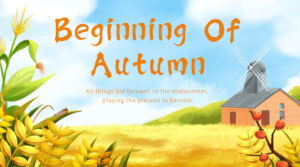
秋の始まりもその一つです 24 中国の太陽用語, 毎年グレゴリオ暦の8月7日か8日の間. 夏の終わりと秋の始まりです. 秋の行事の由来は地理に関係する, 気候, そして農業活動.
秋の始まりは2つの文字で構成されています: 立っていると秋. リーは始まりを指します, そして秋は秋を指します. 秋の始まりの意味は、この時期に本格的に秋が訪れることを指します。.
The name and period of the Liqiu solar term were determined based on ancient astronomical rise and geographical climate changes. The ancients judged seasonal changes by observing the trajectory of the sun and the Earth’s rotation. On the day of the beginning of autumn, when the sun reaches a longitude of 135 °°, the position of the sun directly shining on the Earth moves to a longitude of 135 °°.
Meanwhile, with the arrival of the beginning of autumn, the summer vacation gradually interrupted and entered a cool autumn. Farmers usually start harvesting some summer crops after the beginning of autumn and begin agricultural activities in autumn, such as harvesting and storing crops, preparing to plant autumn crops, 等.
The beginning of autumn is also regarded as a traditional festival, where people hold sacrificial ceremonies to thank for the summer harvest and pray for a bountiful autumn harvest and favorable weather conditions.
Although modern agriculture no longer relies on solar terms to arrange agricultural activities as in ancient times, the beginning of autumn, as one of the traditional Chinese solar terms, still maintains a certain importance and is an important component of ancient Chinese agricultural culture.
全体, the beginning of autumn is an important solar term. The end of summer and the beginning of autumn have astronomical and geographical significance, as well as agricultural and traditional cultural significance. It represents a bountiful harvest and the cherishing and praying of nature.


